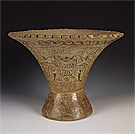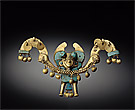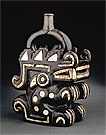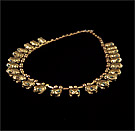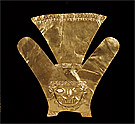Exhibition themes Moche
The Moche dominated the northern coast of Peru for more than 600 years. Their influence spread from the Piura Valley in the north to Ancash in the south. Successful farming and irrigation techniques combined with hunting and coastal fishing to create wealth. Trade was important, notably red spondylus shell from Ecuador and blue lapis lazuli from Chile.
The Moche conquered neighbouring cultures, taking captives for ceremonial beheading. Highly stratified ranks of society meant family and servants could also be sacrificed in elite burials. The supreme deity Ai Apaec, the Decapitator God, demanded sacrificial blood to ensure fertile crops.
Decorated and sculptural ceramics are among the lasting achievements of the Moche. Stirrup vessels—two handles united to form a spout—were imitated for centuries afterwards. Fine-line drawings on ceramics reveal details of hunting, rituals and many facets of everyday life.
The downfall of the Moche is linked to the disastrous consequences of a severe El Niño, which caused 30 years of flooding, then 30 years of drought. Such disruption undermined belief in the supernatural power of the rulers.



